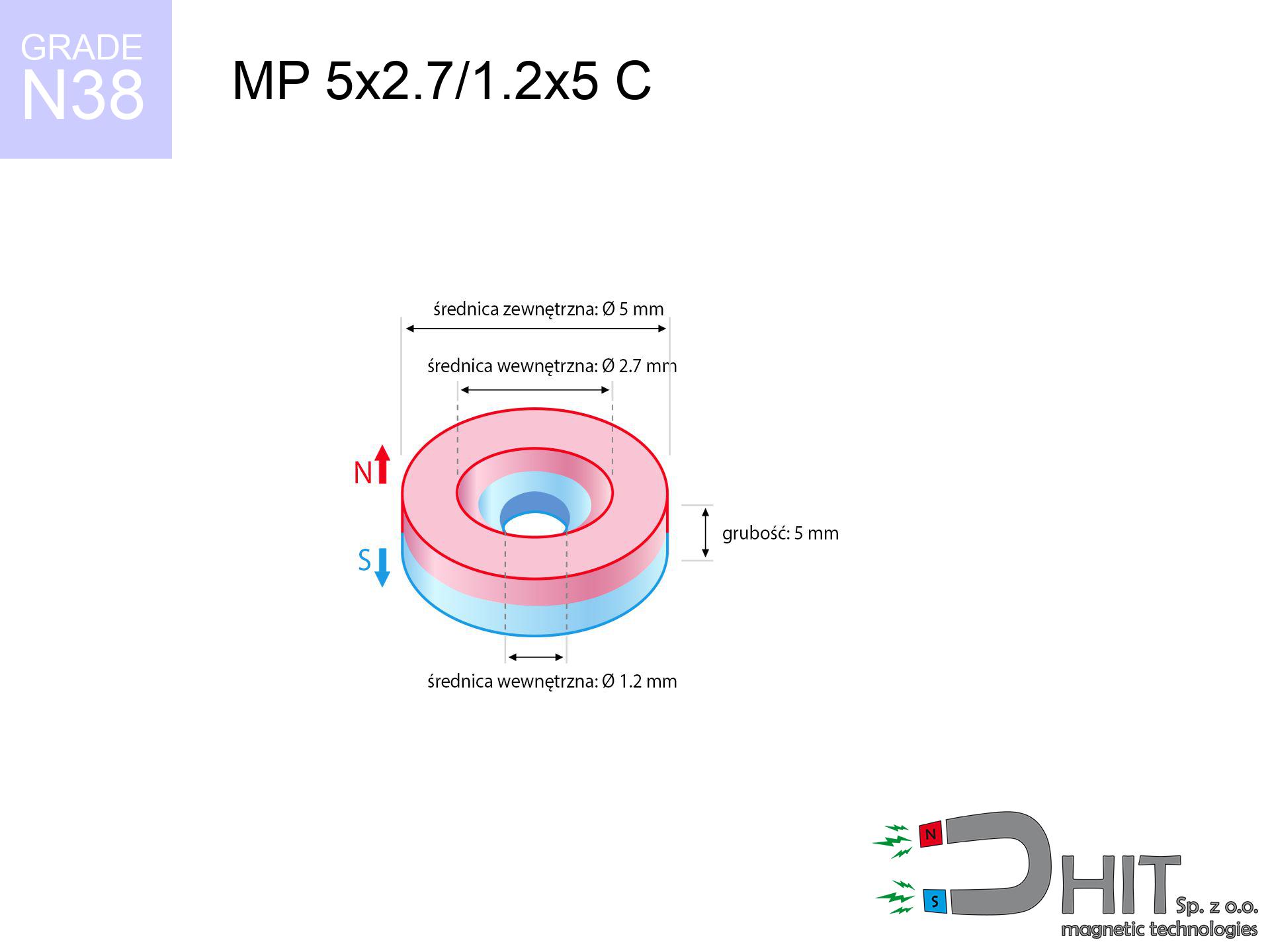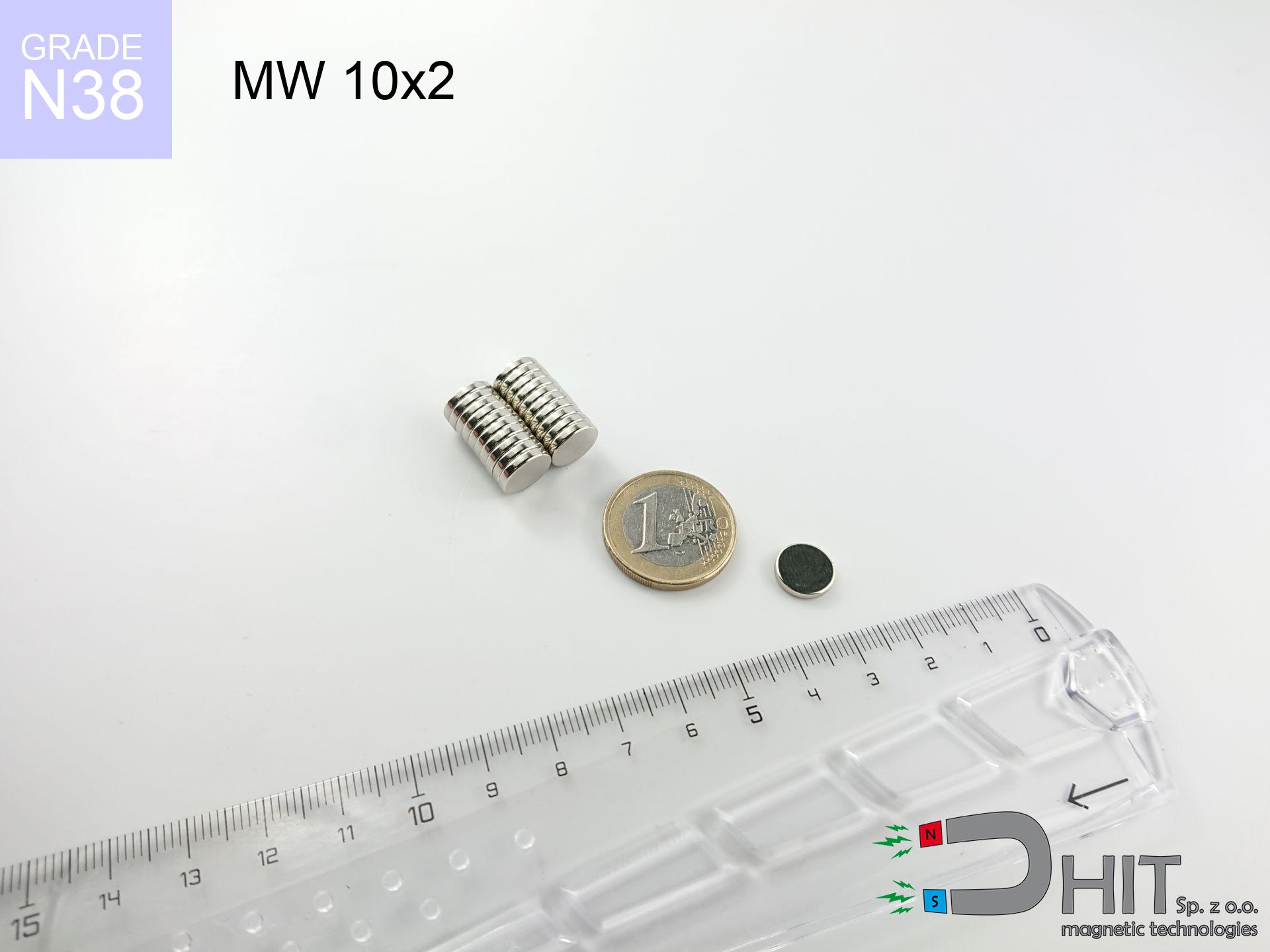MP 5x2.7/1.2x5 C / N38 - neodymium magnet
ring magnet
catalog number 030201
GTIN: 5906301812180
external diameter Ø
5
mm [±0,1 mm]
internal diameter Ø
2.7/1.2
mm [±0,1 mm]
height
5
mm [±0,1 mm]
magnetizing direction
↑ axial
capacity ~
0.56 kg / 5.49 N
magnetic induction ~
56.04 mT / 560 Gs
max. temperature
≤ 80
°C
catalog number 030201
GTIN: 5906301812180
external diameter Ø
5 mm [±0,1 mm]
internal diameter Ø
2.7/1.2 mm [±0,1 mm]
height
5 mm [±0,1 mm]
magnetizing direction
↑ axial
capacity ~
0.56 kg / 5.49 N
magnetic induction ~
56.04 mT / 560 Gs
max. temperature
≤ 80 °C
0.84 ZŁ gross price (including VAT) / pcs +
0.68 ZŁ net price + 23% VAT / pcs
bulk discounts:
need more quantity?Want a better price?
Call us tel: +48 22 499 98 98 or contact us through contact form on our website. You can check the power as well as the shape of neodymium magnet in our magnetic mass calculator power calculator
Orders placed by 2:00 PM will be shipped on the same business day.
Specification: ring magnet 5x2.7/1.2x5 C / N38 ↑ axial
Magnetic properties of the material N38
Physical properties of sintered neodymium magnets Nd2Fe14B
Recommended articles for purchase
Advantages and disadvantages of neodymium magnets NdFeB.
In addition to immense strength, neodymium magnets have the following advantages:
- They do not lose power over time. After 10 years, their power decreases by only ~1% (theoretically),
- They are highly resistant to demagnetization by external magnetic field,
- In other words, thanks to the shiny coating of nickel, gold, or silver, the element acquires an aesthetic appearance,
- They have very high magnetic induction on the surface of the magnet,
- Magnetic neodymium magnets are characterized by hugely high magnetic induction on the surface of the magnet and can operate (depending on the shape) even at temperatures of 230°C or higher...
- The ability for precise shaping and customization to specific needs – neodymium magnets can be produced in various forms and dimensions, which enhances their versatility in applications.
- Significant importance in the industry of new technologies – are used in computer drives, electric drive mechanisms, medical apparatus or various technologically advanced devices.
Disadvantages of neodymium magnets:
- They are prone to breaking as they are fragile when subjected to a powerful impact. If the magnets are exposed to impacts, we recommend using magnets in a steel housing. The steel housing in the form of a holder protects the magnet from impacts and also increases its overall strength,
- Magnets lose their power due to exposure to high temperatures. In most cases, when the temperature exceeds 80°C, these magnets experience permanent loss in strength (although it is worth noting that this is dependent on the shape and size of the magnet). To avoid this problem, we offer special magnets marked with the [AH] symbol, which exhibit high temperature resistance. They can operate even at temperatures as high as 230°C or more,
- They rust in a humid environment. For outdoor use, we recommend using waterproof magnets, such as those made of rubber or plastic,
- The use of a cover - a magnetic holder is recommended due to the limited production capabilities of creating threads or complex shapes in the magnet
- Possible danger associated with microscopic parts of magnets pose a threat, when accidentally ingested, which becomes significant in the context of children's health. Furthermore, tiny parts of these devices are able to be problematic in medical diagnosis in case of swallowing.
Safety Precautions
Neodymium magnets can demagnetize at high temperatures.
Under specific conditions, Neodymium magnets may experience demagnetization when subjected to high temperatures.
If you have a nickel allergy, avoid contact with neodymium magnets.
Studies clearly indicate a small percentage of people who suffer from metal allergies such as nickel. An allergic reaction often manifests as skin redness and rash. If you have a nickel allergy, try wearing gloves or avoid direct contact with nickel-plated neodymium magnets.
Under no circumstances should neodymium magnets be brought close to GPS and smartphones.
Magnetic fields can interfere with compasses and magnetometers used in aviation and maritime navigation, as well as internal compasses of smartphones and GPS devices. There are neodymium magnets in every smartphone, for example, in the microphone and speakers.
Magnets should not be treated as toys. Therefore, it is not recommended for children to have access to them.
Remember that neodymium magnets are not toys. Do not allow children to play with them. Small magnets can pose a serious choking hazard. If multiple magnets are swallowed, they can attract to each other through the intestinal walls, causing significant injuries, and even death.
Keep neodymium magnets away from the wallet, computer, and TV.
Strong magnetic fields emitted by neodymium magnets can destroy magnetic storage media such as floppy disks, credit cards, magnetic ID cards, cassette tapes, video tapes, or other devices. They can also damage televisions, VCRs, computer monitors, and CRT displays. You should especially avoid placing neodymium magnets near electronic devices.
Dust and powder from neodymium magnets are flammable.
Avoid drilling or mechanical processing of neodymium magnets. If the magnet is crushed into fine powder or dust, it becomes highly flammable.
Neodymium magnets are the strongest magnets ever created, and their strength can shock you.
Make sure to review all the information we have provided. This will help you avoid harm to your body and damage to the magnets.
Neodymium magnetic are delicate as well as can easily break and get damaged.
In the event of a collision between two neodymium magnets, it can result in them getting chipped. Despite being made of metal and coated with a shiny nickel plating, they are not as hard as steel. At the moment of collision between the magnets, small sharp metal fragments can be propelled in various directions at high speed. Eye protection is recommended.
People with pacemakers are advised to avoid neodymium magnets.
Neodymium magnets generate strong magnetic fields. As a result, they interfere with the operation of a pacemaker. This happens because such devices have a function to deactivate them in a magnetic field.
Neodymium magnets are primarily characterized by their significant internal force. They attract to each other, and any object that comes in their way will be affected.
Magnets may crack or crumble with uncontrolled connecting to each other. You can't move them to each other. At a distance less than 10 cm you should have them extremely strongly.
To raise awareness of why neodymium magnets are so dangerous, read the article titled How dangerous are strong neodymium magnets?.






![badge holder 40x12x7 [CA] badge holder 40x12x7 [CA]](https://cdn3.dhit.pl/graphics/products/ui40x12x7-vop.jpg)


